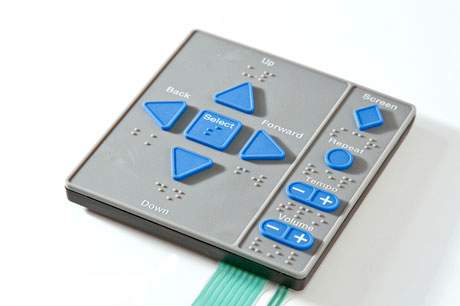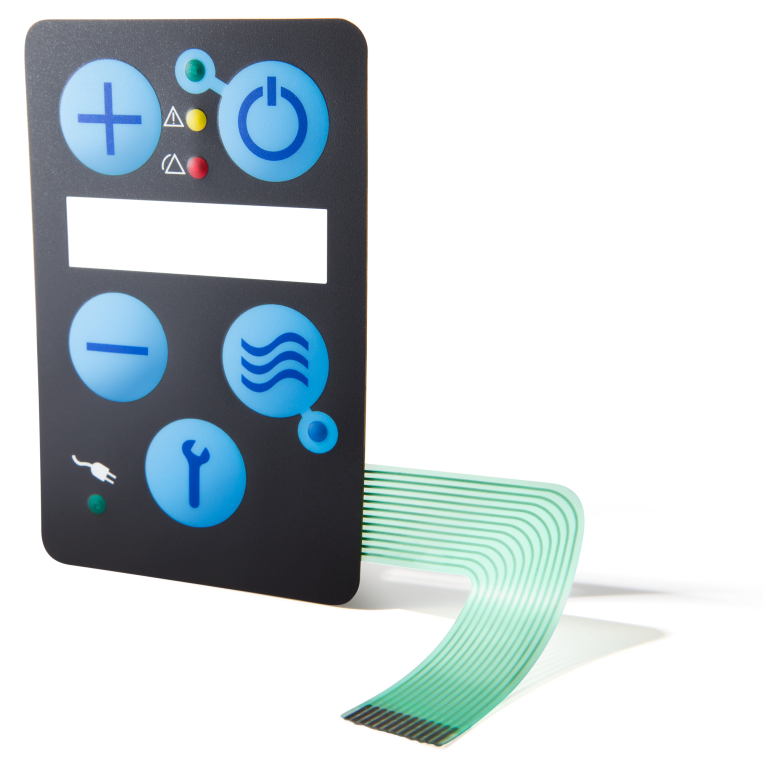Exploring the Production Refine of Membrane Switch for Different Industries
The manufacturing procedure of Membrane buttons is a complicated endeavor that demands accuracy and focus to detail. From selecting ideal products to executing rigorous quality assurance steps, each step plays an important role in making certain functionality. Various markets, consisting of automotive and clinical, rely upon these components for their special applications. Recognizing the complexities of this procedure discloses substantial insights into how these switches are generated and their influence throughout varied sectors.
Understanding Membrane Switches Over: An Overview

Trick Materials Made Use Of in Membrane Switch Production
In Membrane switch production, the choice of essential materials greatly influences performance and longevity. Conductive materials, adhesives, and finishes play essential duties, while substrate choice affects general efficiency and reliability. Understanding these elements is essential for optimizing the style and manufacturing of Membrane switches.
Conductive Products Summary
Conductive materials play an essential function in the capability of Membrane buttons, guaranteeing reputable electrical links within the gadget. Typically used products consist of silver, copper, and carbon-based inks, each offering distinct advantages. Silver is preferred for its high conductivity and durability, making it perfect for applications calling for durable efficiency. Copper, while a little less conductive than silver, is an economical choice typically utilized in published circuits. Carbon-based inks provide a versatile choice, appropriate for applications where versatility and reduced prices are prioritized, although they have actually reduced conductivity contrasted to metal options. The choice of conductive materials directly impacts the overall dependability, lifespan, and efficiency of the Membrane switch, making it a vital consideration in the manufacturing process.
Adhesives and Coatings
Coverings and adhesives are crucial elements in the production of Membrane switches, giving essential bonding and protective residential or commercial properties. These materials guarantee that different layers of the switch, including graphic overlays and wiring, adhere safely to each other, improving durability and performance. Typically used adhesives consist of pressure-sensitive adhesives (PSAs) and epoxy-based formulas, which offer strong bond and resilience. Coatings, such as polyurethane or acrylic, serve to shield against environmental factors, consisting of moisture, abrasion, and chemicals. In addition, coatings can boost responsive comments and aesthetic appeal, contributing to the total customer experience. The selection of ideal adhesives and layers is vital for maximizing performance and longevity in diverse applications across various markets, ensuring that Membrane switches fulfill details operational needs.
Substrate Selection Factors
Substrate option plays a crucial duty in the manufacturing of Membrane switches, as it substantially affects their overall performance and longevity. Key products such as polyester, polycarbonate, and adaptable published circuit boards (FPCBs) are generally utilized for their unique buildings. Polyester is preferred for its cost-effectiveness and resistance to abrasion, making it appropriate for applications with high wear. Polycarbonate offers superior quality and effect resistance, suitable for settings needing high presence. FPCBs offer enhanced versatility and are commonly made use of in intricate layouts. The choice of substrate additionally influences variables like thermal security, chemical resistance, and ease of printing. Inevitably, selecting the suitable substrate is essential for ensuring the functionality and durability of Membrane changes across numerous industries.
The Layout Refine of Membrane Switches Over
The design procedure of Membrane buttons is a vital phase that significantly affects the capability and aesthetic appeals of the end product - membrane switch manufacturer. It begins with specifying the details requirements of the application, including dimensions, button layout, and responsive responses preferences. Developers should consider individual interaction, making certain that the button is instinctive and accessible.Next, materials are chosen based on resilience, flexibility, and environmental resistance. The assimilation of graphics and branding aspects is likewise vital, as it improves visual allure and communication. Prototyping enables repetitive testing, allowing adjustments based on customer comments and performance evaluations.Additionally, the design should account for the electrical elements, such as adapters and circuits, ensuring dependability and simplicity of usage. Ultimately, a successful layout balances functionality, aesthetic appeals, and individual experience, leading the way for efficient production and durable performance in different sectors
Printing Strategies for Membrane Switches
The printing techniques made use of in Membrane switch manufacturing play a crucial function in figuring out the end product's quality and functionality. Screen printing uses benefits such as sturdiness and vibrant shade application, while electronic printing advancements supply adaptability and accuracy in design. Comprehending these techniques can substantially impact the general efficiency of Membrane buttons in different applications.
Screen Printing Advantages
Numerous advantages make display publishing a favored technique for producing Membrane switches. This approach enables premium, vibrant colors and thorough layouts, which are vital for interface applications. Display printing is specifically reliable for applying thick ink layers, boosting resilience and tactile comments. On top of that, it supplies excellent adhesion to different substrates, making certain durability sought after environments. The procedure is affordable for big manufacturing runs, as it minimizes configuration time and waste. Display printing sustains a broad variety of inks, consisting of specialty and UV-curable choices, allowing convenience in design. Its capacity to generate regular results throughout numerous units makes it a dependable option for makers going for quality and effectiveness in Membrane switch manufacturing.
Digital Printing Innovations

Improvements in digital printing modern technology are transforming the production of Membrane buttons, offering producers ingenious remedies that improve style adaptability and performance. Digital printing allows for elaborate layouts and high-resolution graphics, allowing custom branding and functionality without the restrictions of standard approaches. This technique decreases arrangement times and prices, facilitating much shorter production runs and very little waste, making it suitable for companies with varying needs. In addition, innovations in ink formulas supply better resilience and bond, making certain long life in different settings. As sectors progressively seek customized and intricate designs, digital printing sticks out as a necessary technique, establishing a brand-new standard in Membrane button production. The assimilation of these technologies settings suppliers to meet evolving market needs successfully.
Assembly and Layering of Membrane Switch Components
Cautious assembly and layering of Membrane switch components are necessary to ensuring capability and sturdiness. This process starts with the specific alignment of various layers, including the graphic overlay, glue, circuit layer, and support material. Each part visit the website must be thoroughly placed to preserve electric integrity and customer interface responsiveness.During setting up, conductive traces are used to the circuit layer, commonly made from materials like polyester or polycarbonate. This layer is vital, as it transfers signals when stress is applied. The glue utilized for bonding these layers is also chosen for its capability to sustain environmental stresses while maintaining a safe bond.Heat and pressure are frequently applied during the assembly procedure to determine that the layers adhere correctly without endangering the functionality of the switch. Lastly, attention is provided to the edge sealing to safeguard against wetness and impurities, securing the durability of the Membrane button in different industrial applications.
Quality Assurance Actions in Membrane Switch Production
Quality control measures play a crucial duty in making sure the reliability and performance of Membrane switches adhering to the assembly and layering of their components. In the production process, a number of vital assessments are conducted to copyright top quality criteria. These include visual assessments for defects in printing and adhesive application, in addition to practical tests to verify the responsiveness of each switch.Additionally, environmental screening is carried out to evaluate the buttons' resilience against temperature fluctuations and moisture direct exposure. Makers usually apply statistical procedure control (copyright) strategies to check manufacturing uniformity, allowing early discovery of anomalies.Furthermore, traceability systems are developed to track materials and components, making sure accountability and helping with recalls if required. Calibration of equipment and adherence to market requirements are likewise important to maintaining product honesty. Jointly, these quality assurance actions protect the efficiency of Membrane switches over across various applications, eventually enhancing consumer fulfillment.
Applications of Membrane Switches Over Throughout Different Industries
Membrane switches are utilized across a varied array of sectors, showcasing their adaptability and flexibility. In the clinical market, they give reliable and waterproof interfaces for tools such as analysis devices and infusion pumps, making certain health and convenience of use. The auto sector employs Membrane buttons for control panel controls, enabling seamless communication between the chauffeur and automobile systems.In consumer electronics, these switches are located in home appliances and handheld devices, providing a sleek, modern-day visual while boosting performance. Industrial applications also leverage Membrane changes More Info for machinery control board, where toughness and resistance to extreme conditions are essential.Furthermore, the aerospace and defense industries make use of Membrane buttons for cabin instrumentation and communication systems, focusing on integrity and performance under extreme conditions. In general, Membrane buttons play an essential role in boosting the individual experience and functional effectiveness across numerous domain names.
Often Asked Questions
The length of time Does It Take to Make a Membrane Layer Switch?
The manufacturing time for a membrane switch generally ranges from a couple of days to a number of weeks - membrane switch manufacturer. Variables affecting this period consist of style complexity, material accessibility, and manufacturing volume, all impacting the total timeline noticeably
What Is the Normal Life Expectancy of a Membrane Switch?
The common life expectancy of a membrane switch generally ranges from 1 to 5 million actuations, relying on elements such as material top quality, ecological conditions, and use regularity, substantially impacting durability and total performance.
Can Membrane Switches Be Custom-made for Details Applications?
Membrane buttons can certainly be tailored for specific applications. Their style flexibility allows for changes in dimension, form, colors, and graphics, making certain compatibility with unique demands across various industries and boosting capability and customer experience.

Are Membrane Changes Ecologically Pleasant?
The environmental effect of Membrane changes varies. Some products used may not be eco-friendly, while innovations in making processes are increasingly focusing on sustainability, intending to minimize waste and advertise recyclable components in their manufacturing.
What Are the Usual Failing Settings of Membrane Buttons?
Usual failure settings of Membrane switches consist of delamination, sticky failing, deterioration from use, dampness ingress, and electrical failings. These issues can substantially influence functionality, efficiency, and lifespan in numerous applications across different markets. Membrane switches can be tailored to fit details design needs, such as size, capability, and form, making them extremely adaptable.The building and construction typically involves multiple layers, including a graphic overlay, sticky, and a circuit layer, which function together to develop a smooth individual experience. In Membrane button manufacturing, the option of key products substantially affects functionality and longevity. The auto sector employs Membrane switches for dashboard controls, enabling smooth communication in between this content the driver and car systems.In customer electronics, these switches are located in devices and handheld tools, supplying a sleek, modern-day aesthetic while enhancing capability. Industrial applications likewise utilize Membrane switches over for equipment control panels, where toughness and resistance to extreme problems are essential.Furthermore, the aerospace and defense industries make use of Membrane buttons for cockpit instrumentation and communication systems, focusing on integrity and efficiency under extreme conditions. Membrane buttons can certainly be customized for certain applications.